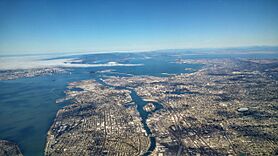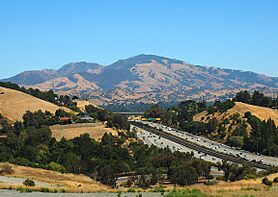East Bay facts for kids
Quick facts for kids
East Bay
|
|
|---|---|
|
Region
|
|
|
The East Bay in 2015, with the Bay Bridge connecting from Oakland to Treasure Island and San Francisco
Oakland and the Bay Bridge
Oakland
Mount Diablo
|
|

Map of incorporated and unincorporated areas in East Bay, California
|
|
| Country | United States |
| State | California |
| Part of | San Francisco Bay Area |
| Principal city | Oakland |
| Other municipalities | |
| Area codes | 510/341, 925 |
The East Bay is a large area on the eastern side of the San Francisco Bay Area in California. It includes cities along the eastern shores of the San Francisco Bay and San Pablo Bay. Over time, it has also grown to include towns further inland in Alameda and Contra Costa counties. In 2010, about 2.5 million people lived here, making it the most populated part of the Bay Area.
Oakland is the biggest city in the East Bay. It is also the third largest city in the entire Bay Area. Oakland is a very important place for transportation on the U.S. West Coast. Its port is the largest in Northern California. As more people moved to the East Bay, many other cities grew big too. These include Fremont, Hayward, Concord, and Berkeley.
Contents
East Bay History: How it Grew
Even though San Francisco was the main focus at first, the East Bay became important in the mid-1800s. It was the easiest part of the Bay Area to reach by land from the east. The Transcontinental Railroad was finished in 1869. Its western end was at the new Oakland Long Wharf. Because of this, the city of Oakland quickly grew into a major seaport.
Today, the Port of Oakland is the biggest port in the Bay Area. It is also the fifth largest port in the United States for shipping containers. In 1868, the University of California was created. A new campus was built in what became Berkeley.
How the 1906 Earthquake Changed the East Bay
The 1906 San Francisco earthquake caused many people to move to the East Bay. This area was not as damaged. The region kept growing fast. To connect the East Bay more easily to San Francisco, the San Francisco–Oakland Bay Bridge was built in 1936.
After World War II, the Bay Area grew even more. The number of people living there doubled between 1940 and 1960. It doubled again by the year 2000. In 1937, the Caldecott Tunnel opened through the Berkeley Hills. This helped cities further east grow, as there was more open land there.
Growth of Inland Cities
Cities in the Diablo Valley, like Concord and Walnut Creek, saw their populations grow ten times or more between 1950 and 1970. The BART train system started in 1972. This also encouraged more building in areas further away in the East Bay. Today, the valleys east of the Berkeley Hills have large, wealthy suburban communities. Examples include Walnut Creek, San Ramon, and Pleasanton.
The East Bay is not an official region with exact borders. It is generally described as including Alameda and Contra Costa counties. As cities expand eastward, new areas are often called part of the East Bay. For example, in 1996, the BART train line was extended to Pittsburg. This helped connect Pittsburg and Antioch to the East Bay.
Cities and Towns in the East Bay
Most of the East Bay is covered in cities and towns. There are some hills, parks, and farmland in the eastern parts of Contra Costa and Alameda Counties. The shoreline of the East Bay is a busy urban area. Several cities there have over 100,000 residents. These include Oakland, Hayward, Fremont, Richmond, and Berkeley.
In the inland valleys, east of the Berkeley Hills, most of the land is also developed. This is especially true on the eastern edge of Contra Costa county and the Tri-Valley area. In these inland valleys, there are fewer people per square mile, and the cities are smaller. Only Antioch and Concord in the inland valleys have more than 100,000 residents.
Here are some of the cities and towns in the East Bay:
East Bay Culture and Fun Things to Do
The East Bay has a unique culture. There are free weekly newspapers like the East Bay Express and The East Bay Monthly. These papers have reported on the area's culture and politics for many years.
Festivals and Music
The Solano Avenue Stroll is the oldest and largest street festival in the San Francisco Bay Area. It happens every September on Solano Avenue in Albany and Berkeley.
Many famous music groups started in the East Bay. These include Creedence Clearwater Revival, Green Day, Primus, Rancid, Tower of Power, The Pointer Sisters, MC Hammer, and Tupac Shakur. The East Bay is a big center for rock, folk, funk, jazz, hip hop, and soul music.
The East Bay is also known for Bay Area thrash metal music. Bands like Exodus and Metallica have strong ties to the area.
Places to Visit
There are many great places for music and sports in the East Bay. These include the Oakland Arena and the Oakland Coliseum, where the Oakland A's baseball team plays. Other venues are the Oakland Paramount Theater and the UC Berkeley Greek Theater.
Major museums in the area include the Oakland Museum of California, the Lawrence Hall of Science, and the Chabot Space and Science Center.
The East Bay Regional Parks District manages over fifty parks. Many of these parks have large areas of wildlands right next to cities. Tilden Regional Park is a huge park (about 2,000 acres) next to Berkeley. Briones Regional Park is another large wildlands park (5,000 acres) near Walnut Creek.
The East Bay also has an important political history. The Black Panther Party, a revolutionary movement, was founded in Oakland.
Getting Around: Transportation in the East Bay
All major roads that cross the San Francisco Bay lead to the East Bay counties. Important highways in the East Bay include Interstates 80, 580, and 680.
Public Transit Options
AC Transit is the main bus company for the region. It provides bus service throughout Alameda and Contra Costa counties. Other bus services include County Connection and WHEELS.
You can also take a ferry from Jack London Square and Alameda Harbor to San Francisco. Future ferry service is planned from Richmond Ferry Terminal and Hercules.
Biking is also popular. City and county groups, along with organizations like the East Bay Bicycle Coalition, encourage bicycle use. There are many paths for walking and biking, such as the San Francisco Bay Trail and the Iron Horse Regional Trail.
Train Services
Train service in the East Bay started very early. The First transcontinental railroad connected the Bay to Sacramento. This railroad eventually became the Niles Canyon Railway. Today, the Altamont Corridor Express (ACE) runs commuter trains through Niles Canyon to San Jose.
The Key System used to provide streetcar service across the East Bay. These streetcars connected to San Francisco ferries. When the San Francisco–Oakland Bay Bridge opened in 1936, Key System cars could travel directly across the bridge. The streetcars were replaced by buses in 1948. The Key System's services were taken over by AC Transit in 1960.
The East Bay's modern train system is Bay Area Rapid Transit, or BART. It was mainly built to take commuters to San Francisco through the Transbay Tube, and also to Oakland and Berkeley.
Amtrak trains also serve the East Bay. The California Zephyr train ends in Emeryville. Other Amtrak trains like the Coast Starlight and San Joaquin stop at stations across the East Bay.
East Bay Economy and Jobs
The East Bay has a mix of different types of businesses. These include services, manufacturing, and both small and large companies. Many well-known businesses have their main offices here. Some examples are Kaiser Permanente, Chevron, and Safeway.
The East Bay Economic Development Alliance works to promote the East Bay as an important place for business growth.
Major Employers in the East Bay
The East Bay is a highly developed area with many job opportunities. Besides the county governments, some of the largest employers are:
- University of California, Berkeley (about 20,000 employees)
- AT&T Inc. (about 11,000 employees)
- The U.S. Postal Service (around 10,000 employees)
- Tesla (10,000 employees)
- Lawrence Livermore National Laboratory (about 8,750 employees)
- Chevron Corp. (world headquarters in San Ramon)
- Safeway (world headquarters in Pleasanton)
- Bank of America
- PG&E
- Kaiser Permanente (U.S. headquarters in Oakland)
- Wells Fargo
- Workday (world headquarters in Pleasanton)
- Lawrence Berkeley National Laboratory
Other major companies with headquarters in the East Bay include Clorox, Dreyer's, Peet's Coffee, and Pixar Animation Studios. Tesla, Inc. now uses part of the former NUMMI car manufacturing plant. This is still the only car manufacturing plant in California.
Higher Education: Colleges and Universities
The East Bay has many colleges and universities, both public and private.
|
Colleges (Two-year)
|
Universities
|
Images for kids
See also
 In Spanish: Este de la Bahía (área de la Bahía de San Francisco) para niños
In Spanish: Este de la Bahía (área de la Bahía de San Francisco) para niños









